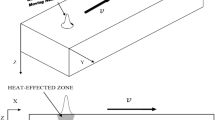Abstract
We have numerically simulated the temperature distribution in the living biological tissues for more effective thermal treatment of tumor cells based on the DPL (Dual Phase Lag) model of bioheat transfer equation having a laser heat source. The temperature distribution from the center of the spherical tissue towards the outer surface (taken as skin surface) is simulated. The numerical solutions of the DPL model for one-dimensional bioheat transfer equation along with laser heating conditions are obtained by using the finite difference method. The effects of the phase lag of the heat flux and the temperature gradient, the blood perfusion rate, thermal conductivity, and the laser heating parameter have been presented. The study shows that the phase lags and thermal conductivity have a greater influence on the temperature distribution for hyperthermia treatment in cancer therapy.
Access this chapter
Tax calculation will be finalised at checkout
Purchases are for personal use only
Similar content being viewed by others
References
Roemer RB (1999) Engineering aspects of hyperthermia therapy. Annu Rev Biomed Eng 1:347–376
Minkowycz WJ, Sprrow EM, Abraham JP (2009) Advances in numerical heat transfer, vol 3. CRC Press, Boca Raton, USA
Ng EYK, Chua LT (2001) Quick numerical assessment of skin burn injury with spreadsheet in PC. J Mech Med Biol 1:1–10
Ng EYK, Chua LT (2002) Comparison of one and two dimensional programmes for predicting the state of skin burns. Burns 28:27–34
Dua R, Chakraborty S (2004) A novel modeling and simulation technique of photo-thermal interactions between lasers and living biological tissues undergoing multiple changes in phase. Comput Biol Med 35:447–462
Pennes HH (1948) Analysis of tissue and arterial blood temperature in the resting forearm. J Appl Physiol 1:93–122
Klinger HG (1974) Heat transfer in perfused biological tissue. I. General theory. Bull Mathe Biol 36:403–415
Wulff W (1974) The energy conservation equation for living tissues. IEEE Trans-Biomed Eng 21:494–495
Chen MM, Holmes KR (1980) microvascular contributions in tissue heat transfer. Ann New York Acad Sci 335:137–150
Shih TC, Yuan P, Lin WL (2007) Hong Sen Kou, Analytical analysis of the Pennes bioheat transfer equation with sinusoidal heat flux condition on skin surface. Med Eng Phys 29:946–953
Deng ZS, Liu J (2002) Analytical study on bioheat transfer problems with spatial or transient heat on skin surface or inside biological bodies. J Biomed Eng 124:638–649
Diller KR (1992) Modeling of bioheat transfer processes at high and low temperatures. Adv Heat Trans 22:157–357
Bhowmik A, Singh R, Repaka R, Mishra SC (2013) Conventional and newly developed bioheat transport models in vascularized tissues: A review. J Therm Biol 38:107–125
Nakayama A, Kuwahara F (2008) A general bioheat transfer model based on the theory of porous media. Int J Heat Mass Transf 51:3190–3199
Cattaneo C (1958) A form of heat conduction equation which eliminates the paradox of intantaneous propagation. Compte Rendus 247:431–433
Vernotte P (1961) Some possible complications in the phenomena of thermal conduction. Compte Rendus 252:2190–2191
Weymann HD (1967) Finite speed of propagation in heat conduction, diffusion, and viscous shear motion. Am J Phys 35:488–96
Tzou DY (1996) Macro- to microscale heat transfer: the lagging behavior. Taylor and Francis Washington, DC
Tzou DY (1995) The generalized lagging response in small-scale and high-rate heating. Int J Heat Mass Transf 38:3231–3240
Antaki PJ (2000) Effect of dual-phase-lag heat conduction on ignition of a solid. J Thermophys Heat Transfer 14:276–78
Zhang Y (2009) Generalized dual-phase lag bioheat equations based on nonequilibrium heat transfer in living biological tissues. Int J Heat Mass Transf 52:4829–834
Xu F, Lu T, Seffen K (2008) Dual-phase-lag model of skin bioheat transfer. International Conference on BioMedical Engineering and Informatics 1
Poor HZ, Moosavi H, Moradi A (2016) Analysis of the dual phase lag bio-heat transfer equation with constant and dime dependent heat flux conditions on skin surface. J Therm Sci 20:1457–1472
Liu KC, Chen HT (2009) Analysis for the dual-phase-lag bio-heat transfer during magnetic hyperthermia treatment. Int J Heat Mass Transf 52:1185–1192
Afrin N, Zhou J, Zhang Y, Tzou DY, Chen JK (2012) Numerical simulation of thermal damage to living biological tissues induced by laser irradiation based on a generalised dual phase lag model. Numerical Heat Transfer 61:483–501
Singh S, Kumar S (2014) Numerical study on triple layer skin tissue freezing using dual phase lag bio-heat model. Int J Therm Sci 86:12–20
Kumar P, Kumar D, Rai KN (2016) Non-linear dual-phase-lag model for analyzing heat transfer phenomena in living tissues during thermal ablation. J Therm Biol 60:204–212
Peng HS, Chen CL (2011) Application of hybrid differential transformation and finite difference method on the laser heating problem. Numer Heat Transfer, Part A 59:28–42
Lin SY, Lai HY, Chen CK (2011) Hyperthermia treatment for living tissue with laser heating problems by the differential transformation method. Numer Heat Transfer, Part A 60:499–518
Liu KC, Chen HT (2009) Analysis for the dual-phase-lag bio-heat transfer during magnetic hyperthermia treatment. Int J Heat Mass Trans 52:1185–1192
Author information
Authors and Affiliations
Corresponding author
Editor information
Editors and Affiliations
Rights and permissions
Copyright information
© 2021 The Author(s), under exclusive license to Springer Nature Singapore Pte Ltd.
About this paper
Cite this paper
Shit, G.C., Bera, A. (2021). DPL Model for Hyperthermia Treatment of Cancerous Cells Using Laser Heating Technique: A Numerical Study. In: Giri, D., Buyya, R., Ponnusamy, S., De, D., Adamatzky, A., Abawajy, J.H. (eds) Proceedings of the Sixth International Conference on Mathematics and Computing. Advances in Intelligent Systems and Computing, vol 1262. Springer, Singapore. https://doi.org/10.1007/978-981-15-8061-1_28
Download citation
DOI: https://doi.org/10.1007/978-981-15-8061-1_28
Published:
Publisher Name: Springer, Singapore
Print ISBN: 978-981-15-8060-4
Online ISBN: 978-981-15-8061-1
eBook Packages: Intelligent Technologies and RoboticsIntelligent Technologies and Robotics (R0)




